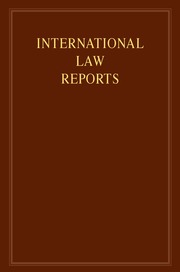Article contents
Taba Award (Arbitral Award in the Dispute Concerning Certain Boundary Pillars Between The Arab Republic of Egypt and the State of Israel)
Published online by Cambridge University Press: 01 January 2021
Abstract
Territory — Boundaries — Acceptance by States involved — Principle of stability of boundaries — Application — Acts evidencing an acceptance of the boundary — Administrative acts — Maps — Absence of formal protest
Territory — Boundaries — Delimitation — Treaty of delimitation — Interpretation — Demarcation — Relationship between delimitation and demarcation — Alleged inconsistency between principles in treaty of delimitation and demarcation on the ground — Whether treaty should prevail — Whether demarcation to be treated as an authoritative interpretation of treaty — 1906 Agreement between Egypt and Turkey regarding boundary between Egypt and Palestine — Demarcation of boundary through construction of boundary pillars — Whether pillars wrongly located — Requirement that pillars be intervisible — Whether departed from — Significance of departure — Whether line as demarcated accepted by States involved — Subsequent reference to line defined by 1906 Agreement — Whether a reference to line as demarcated or to principles contained in the Agreement
Territory — Critical date — Principle of the critical date or the critical period — Treaty of Peace between Egypt and Israel, 1979 — Description of boundary between Egypt and Israel as “the recognized international boundary between Egypt and the former mandated territory of Palestine” — Effect on critical date — Whether entire Mandate period to be treated as critical period
Arbitration — Competence of arbitration tribunal — Arbitration Compromis between Egypt and Israel, 1986 — Scope of question referred to Tribunal — Boundary dispute — Tribunal required to determine location of boundary pillars — Tribunal required to choose between locations claimed by Parties — Evidence that pillar situated at location other than those claimed by Parties — Principle of relative strength of claims — Reference to “final” pillar — Evidence that final pillar may have been situated at location not claimed by either Party — Effect on competence of Tribunal — Whether Tribunal confronted with non licet — Whether arbitration frustrated — Whether Tribunal required to prevent frustration of arbitration
Arbitration — Compromis — Interpretation — Terms used in Compromis taken from earlier treaty — Whether these terms to be given same meaning in both agreements
Arbitration — Evidence — Recognition of boundary by States — Evidence of acts constituting recognition of boundary — Publication of reference work — Whether an administrative act — Statistical Yearbook published by government
Sources of international law — General — State practice — Acts constituting State practice — Publication of reference work
Sources of international law — Protest and acquiescence — Estoppel — Acceptance of boundary by States over a period of time — Whether precluding subsequent challenge to location of boundary pillars
State succession — Boundaries — Succession of new State to boundaries of former mandated territory — Israel
Treaties — Interpretation — Subsequent conduct of parties — Treaty providing for delimitation of boundary — Whether subsequent demarcation on the ground an authoritative interpretation of the treaty — Effect of subsequent conduct in relation to boundary — Same terms used in two different treaties — Later treaty reflecting language of earlier treaty — Whether terms to be given same interpretation in both agreements
War and armed conflict — Peace treaties — Treaty of Peace between Egypt and Israel, 1979 — Implementation — Boundary between Egypt and Israel — Arbitration in accordance with Peace Treaty
Keywords
- Type
- Case Report
- Information
- Copyright
- © Cambridge University Press 1989
- 1
- Cited by




